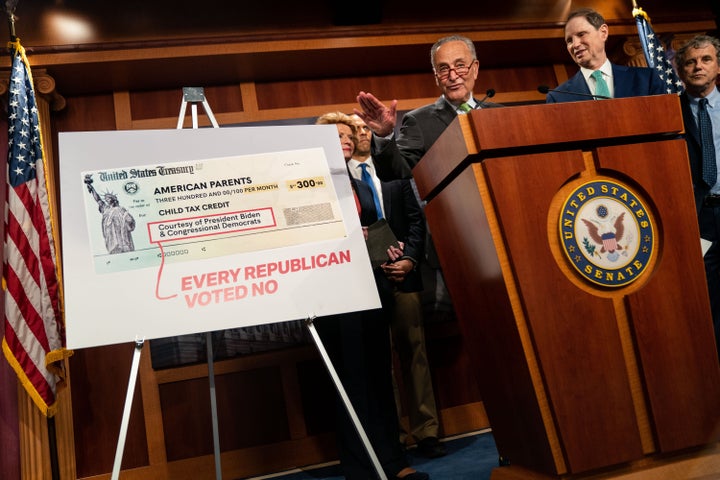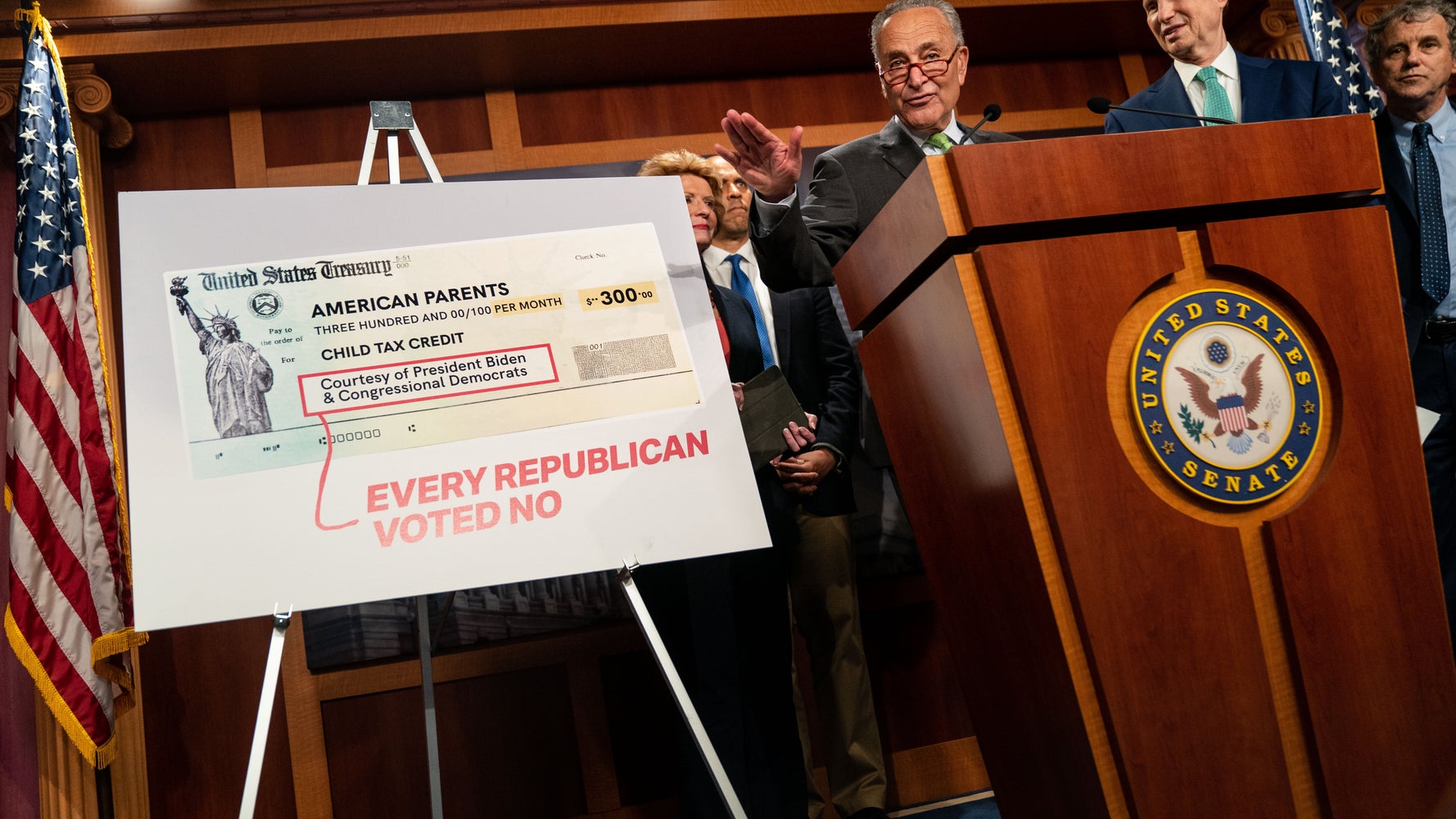[ad_1]
Administrative issues could threaten Democrats’ goal of using a $300 monthly benefit for parents to cut child poverty in half. But Democrats don’t want to talk about them.Â
Parents nationwide began receiving money on Thursday as part of the largest anti-poverty program implemented since the 1960s. The new child tax credit, which is part of President Joe Biden’s signature American Rescue Plan, has already delivered checks to the parents of 60 million children.
Democrats are, understandably, eager to celebrate the policy. The tax credit is life-changing for families: It goes up to $3,600 per child and is fully refundable, meaning it will reach low-to-no-income parents and that families can see more of the credit as a cash benefit. The IRS is distributing the credit in advance as monthly payments of up to $300 per child instead of leaving parents to wait until tax season.Â
Still, the program could stop short of meeting its potential. For weeks, nonprofit groups and legal aid organizations across the country have sounded the alarm that the government’s website to sign up the poorest American families for the tax credit — families that do not typically pay taxes and therefore are not automatically signed up for the benefit — is too difficult to use.
The website is only in English and requires users to have an email address. It’s also difficult to navigate on mobile devices, which is the primary way poor families can access the internet, and it requires a level of tax literacy that is often too difficult for nontraditional tax filers to understand.
“In our assessment it’s pretty much inaccessible to a lot of underserved communities,†Jen Burdick, an attorney with the Community Legal Services of Philadelphia, told HuffPost when the portal launched. “All in all, it means most people cannot do this on their own.â€
Burdick said she is optimistic that addressing the issues will remain a priority for the administration, as so many families have already benefited from the program.
“The non-filers portal continues to have issues that limit the lowest income families’ access, but I’m hopeful that accessibility will remain a priority throughout the federal government going forward,†she said.
Congressional Democrats, however, don’t want to hear it. Asked on Thursday why the government hasn’t fixed accessibility issues with the online portal, Senate Majority Leader Chuck Schumer rejected the notion with a forceful response: “No.â€
“It’s a very simple way to file,†the New York Democrat told HuffPost. “I went on the website myself. It’s very simple and easy to do as long as your kids have a social security number, whether you are a citizen or have an [Individual Taxpayer Identification Number], go to the website.â€
It’s not clear how Schumer, who famously still uses a flip phone, tried to access the nonfiler portal. When HuffPost attempted to sign onto the portal with a mobile device, text stretched across the screen, making it difficult to use. The site also contained tax language that legal aides say is hard for many to understand.

Schumer wasn’t the only one who was defensive.Â
Sen. Sherrod Brown (D-Ohio), who co-wrote the bill and has previously acknowledged issues with the portal to HuffPost, jumped in as well.Â
“I spent a half an hour with Commissioner Rettig two weeks ago, and he and I agreed that having that portal and having that portal work … is the most important thing we’ve done in our public lives,†Brown said, referring to the head of the IRS.Â
The White House also tried to preempt these concerns in a call with reporters on Wednesday night, acknowledging the issues with the portal. But officials emphasized that more than 20 million kids in low-income families will automatically get the benefit.
“We are very, very, very focused on the nonfiler issue and getting people in the door, but the child tax credit begins to tackle child poverty … when these payments go out,†a White House official said.
Roughly 90% of American families will receive the child tax credit automatically. Among the remaining 10% — which covers the poorest Americans — 470,000 families, with roughly 720,000 children, had signed up through the nonfiler tool before the first round of checks went out Thursday.Â
The number is expected to gradually increase throughout the year, but the implications of these accessibility issues are significant: There are millions of children in deeply poor nonfiler households that could be missing out on this benefit.
Senate Democrats have made a point to emphasize the anti-poverty impacts of this legislation.Â
“We will not accept that the United States of American should have among the highest child poverty rates of any industrialized country in the world, that child poverty has to be a permanent feature of our economy or our democracy,†Sen. Michael Bennet (D-Colo.), who co-sponsored this bill, said Thursday. “Today we are saying no.â€
Before Thursday, several lawmakers, including Brown, told HuffPost they had made recommendations to the IRS for changes to the nonfiler tool.
The IRS has been under a lot of pressure to not only stand up this child tax credit program with advance payments, but also to distribute the last round of stimulus checks and manage tax season. More than 30 million tax refunds have been delayed.
Getting the advance payments for the child tax credit out as early as July 15 was a victory on its own.
And fixing the issues with the nonfiler tool is complicated. The government is banned from creating its own free tax-filing tool because of a law sponsored by the late Rep. John Lewis (D-Ga.) in 2019. Instead, it must rely on a group of private companies, like Intuit, which is behind TurboTax, to build the website.Â
Intuit told HuffPost that it built the website based on the IRS’s requirements. Among those requirements is using usability design principles — like making the process feel familiar and guided. The White House said it is working with the IRS to address issues with the tool over time, but an administration official would not put a timeline to any changes.
Sen. Ron Wyden (D-Ore.) told HuffPost the government is investing in education campaigns across the country to get more people signed up. The White House set up a website, in both English and Spanish, explaining the program and who is eligible, and the administration has partnered with nonprofit organizations across the country to reach out to families in need and get them into the program.
Biden’s administration is very familiar with these administrative problems. They ran into the exact same issue with the Economic Impact Payments — or stimulus checks — last year, which were distributed through the IRS using a similar portal.Â
The program is new, and it’s too early to say whether it can meet Democrats’ goals of cutting child poverty by half. But making it easier for this population to access the benefit will be a crucial step.
Calling all HuffPost superfans!
Sign up for membership to become a founding member and help shape HuffPost’s next chapter
[ad_2]
Source link






